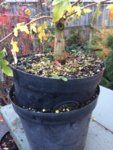I picked up a Dawn Redwood (Schulman's Nordlicht cultivar) last spring. Really interesting foliage, but a painfully slow growing dwarf cultivar.
Anyway, in my excitement over the beautiful, soft foliage, and promising trunk/branch taper and branch structure, I never cleared away the soil to peek at the root flair/nebari. After getting it home, cutting off the top of the nursery container, and wiring some movement into the branches, I was saddened to see this terrible reverse taper below the original soil level:

So this spring I attempted to layer the tree, hoping to establish a new set of roots radiating from just below the first branch pictured above. I'm in zone 5b and the layer was started on April 21, 2018, just as buds were opening.
The tree fully leafed out and looked great for nearly two months... until this week. It started drooping, curling, shriveling:

I figured something was amiss, so I opened the plastic bag holding the moist sphagnum to see if the layer was a total failure. It appears to have been a failure, but I'm probing for feedback here from those who have direct, first-hand experience with layers.
The cambium calloused, but never sent out any roots (I did apply IBA when I made the incisions and before I wrapped it up last April)

Seems the original root system finally gave up the ghost... and there were no new roots from the layer to supply the foliage. Now there's no healthy foliage to feed the cambium. Really bummed about this.
Just wondering if it's worth re-wounding the cambium, wrapping it all back up, and dropping this sad tree in the shade in the hopes that it might throw roots sometime this year, and with proper winter protection, new leaves might emerge in the spring.
Thoughts?
Thanks in adbvance
Noah
Anyway, in my excitement over the beautiful, soft foliage, and promising trunk/branch taper and branch structure, I never cleared away the soil to peek at the root flair/nebari. After getting it home, cutting off the top of the nursery container, and wiring some movement into the branches, I was saddened to see this terrible reverse taper below the original soil level:

So this spring I attempted to layer the tree, hoping to establish a new set of roots radiating from just below the first branch pictured above. I'm in zone 5b and the layer was started on April 21, 2018, just as buds were opening.
The tree fully leafed out and looked great for nearly two months... until this week. It started drooping, curling, shriveling:

I figured something was amiss, so I opened the plastic bag holding the moist sphagnum to see if the layer was a total failure. It appears to have been a failure, but I'm probing for feedback here from those who have direct, first-hand experience with layers.
The cambium calloused, but never sent out any roots (I did apply IBA when I made the incisions and before I wrapped it up last April)

Seems the original root system finally gave up the ghost... and there were no new roots from the layer to supply the foliage. Now there's no healthy foliage to feed the cambium. Really bummed about this.
Just wondering if it's worth re-wounding the cambium, wrapping it all back up, and dropping this sad tree in the shade in the hopes that it might throw roots sometime this year, and with proper winter protection, new leaves might emerge in the spring.
Thoughts?
Thanks in adbvance
Noah

